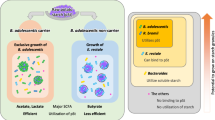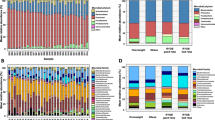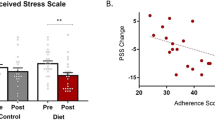Abstract
The populations of dominant species within the human colonic microbiota can potentially be modified by dietary intake with consequences for health. Here we examined the influence of precisely controlled diets in 14 overweight men. Volunteers were provided successively with a control diet, diets high in resistant starch (RS) or non-starch polysaccharides (NSPs) and a reduced carbohydrate weight loss (WL) diet, over 10 weeks. Analysis of 16S rRNA sequences in stool samples of six volunteers detected 320 phylotypes (defined at >98% identity) of which 26, including 19 cultured species, each accounted for >1% of sequences. Although samples clustered more strongly by individual than by diet, time courses obtained by targeted qPCR revealed that ‘blooms’ in specific bacterial groups occurred rapidly after a dietary change. These were rapidly reversed by the subsequent diet. Relatives of Ruminococcus bromii (R-ruminococci) increased in most volunteers on the RS diet, accounting for a mean of 17% of total bacteria compared with 3.8% on the NSP diet, whereas the uncultured Oscillibacter group increased on the RS and WL diets. Relatives of Eubacterium rectale increased on RS (to mean 10.1%) but decreased, along with Collinsella aerofaciens, on WL. Inter-individual variation was marked, however, with >60% of RS remaining unfermented in two volunteers on the RS diet, compared to <4% in the other 12 volunteers; these two individuals also showed low numbers of R-ruminococci (<1%). Dietary non-digestible carbohydrate can produce marked changes in the gut microbiota, but these depend on the initial composition of an individual's gut microbiota.
Similar content being viewed by others
Log in or create a free account to read this content
Gain free access to this article, as well as selected content from this journal and more on nature.com
or
Accession codes
References
Abell GCJ, Cooke CM, Bennett CN, Conlon MA, McOrist AL . (2008). Phylotypes related to Ruminococcus bromii are abundant in the large bowel of humans and increase in response to a diet high in resistant starch. FEMS Microbiol Ecol 66: 505–515.
Aminov RI, Walker AW, Duncan SH, Harmsen HJM, Welling GW, Flint HJ . (2006). Molecular diversity, cultivation, and improved FISH detection of a dominant group of human gut bacteria related to Roseburia spp. or Eubacterium rectale. Appl Environ Microbiol 72: 6371–6376.
Ashelford KE, Chuzhanova NA, Fry JC, Jones AJ, Weightman AJ . (2005). At least 1 in 20 sequence records currently held in public repositories is estimated to contain substantial anomalies. Appl Environ Microbiol 71: 7724–7736.
Ashelford KE, Chuzhanova NA, Fry JC, Jones AJ, Weightman AJ . (2006). New screening software shows that most recent large 16S rRNA gene clone libraries contain chimeras. Appl Environ Microbiol 72: 5734–5741.
Bird AR, Brown IL, Topping DL . (2000). Starches, resistant starches, the gut microflora and human heath. Curr Issues Intest Microbiol 1: 25–37.
Bouhnik Y, Raskine L, Simoneau G, Vicaut E, Neut C, Flourie B et al. (2004). The capacity of nondigestible carbohydrates to stimulate faecal bifidobacteria in healthy humans: a double blind, randomized, placebo-controlled, parallel-group, dose response relation study. Am J Clin Nutr 80: 1658–1664.
Brinkworth GD, Noakes M, Clifton PM, Bird AR . (2009). Comparative effects of very low carbohydrate, high fat and high carbohydrate, low-fat weight loss diets on bowel habit and faecal short chain fatty acids and bacterial populations. Brit J Nutr 101: 1493–1502.
Cani PD, Amar J, Iglesias MA, Poggi M, Knauf C, Bastelica D et al. (2007). Metabolic endotoxemia initiates obesity and insulin resistance. Diabetes 56: 1761–1772.
Cole JR, Wang Q, Cardenas E, Fish J, Chai B, Farris RJ et al. (2009). The Ribosomal Database Project: improved alignments and new tools for rRNA analysis. Nucleic Acids Res 37: D141–D145.
Costello EK, Lauber CL, Hamady M, Fierer N, Gordon JI, Knight R . (2009). Bacterial community variation in human body habitats across time and space. Science 326: 1694–1697.
Duncan SH, Belenguer A, Holtrop G, Johnstone AM, Flint HJ, Lobley GE . (2007). Reduced dietary intake of carbohydrates by obese subjects results in decreased concentrations of butyrate and butyrate-producing bacteria in feces. Appl Environ Microbiol 73: 1073–1078.
Duncan SH, Lobley GE, Holtrop G, Ince J, Johnstone AM, Louis P et al. (2008). Human colonic microbiota associated with diet, obesity and weight loss. Int J Obesity 32: 1720–1724.
Eckburg PB, Bernstein CN, Purdom E, Dethlefsen L, Sargent M, Gill SR et al. (2005). Diversity of the human intestinal microbial flora. Science 308: 1635–1638.
Englyst HN, Cummings JH . (1988). Improved method for measurement of dietary fiber as non-starch polysaccharides in plant foods. J Assoc Off Anal Chem 1: 247–286.
Englyst HN, Kingman SM, Cummings JE . (1992). Classification and measurement of nutritionally important starch fractions. Eur J Clin Nutr 46 (Suppl 2): S33–S50.
Food Standards Agency (2002). McCance and Widdowson's The Composition of Foods, 6th summary edn. Royal Society of Chemistry: Cambridge.
Flint HJ, Bayer EA, Rincon MT, Lamed R, White BA . (2008). Polysaccharide utilization by gut bacteria: potential for new insights from genomic analysis. Nat Rev Microbiol 6: 121–131.
Flint HJ, Duncan SH, Scott KP, Louis P . (2007). Interactions and competition within the microbial community of the human colon: links between diet and health. Environ Microbiol 9: 1101–1111.
Florin THF, Zhu G, Kirk KM, Martin NG . (2000). Shared and unique environmental factors determine the ecology of methanogens in humans and rats. Am J Gastroenterol 95: 2872–2879.
Frank JA, Reich CI, Sharma S, Weisbaum JS, Wilson BA, Olsen GJ . (2008). Critical evaluation of two primers commonly used for amplification of bacterial 16S rRNA genes. Appl Environ Microbiol 74: 2461–2470.
Franks AH, Harmsen HJM, Raangs GC, Jansen GJ, Schut F, Welling GW . (1998). Variations of bacterial populations in human feces measured by fluorescent in situ hybridisation with group-specific 16S rRNA-targeted oligonucleotide probes. Appl Environ Microbiol 64: 3336–3345.
Furrie E, Macfarlane S, Kennedy A, Cummings JH, Walsh SV, O’Neill DA et al. (2005). Synbiotic therapy (Bifidobacterium longum/Synergy 1) initiates resolution of inflammation in patients with active ulcerative colitis: a randomised controlled pilot trial. Gut 54: 242–249.
Gill CIR, Rowland IR . (2002). Diet and cancer: assessing the risk. Br J Nutr 88 (Suppl 1): S73–S87.
Hold GL, Pryde SE, Russell VJ, Furrie E, Flint HJ . (2002). Assessment of microbial diversity in human colonic samples by 16S rDNA sequence analysis. FEMS Microbiol Ecol 39: 33–39.
Johnson M, Zaretskaya I, Raytselis Y, Merezhuk Y, McGinnis S, Madden TL . (2008). NCBI BLAST: a better web interface. Nucleic Acids Res 36: W5–W9.
Kovatcheva-Datchary P, Egert M, Maathuis A, Rajilic-Stojanovic M, de Graaf AA, Smidt H et al. (2009). Linking phylogenetic identities of bacteria to starch fermentation in an in vitro model of the large intestine by RNA-based stable isotope probing. Environ Microbiol 11: 914–926.
Iino T, Mori K, Tanaka K, Suzuki K-I, Harayama S . (2007). Oscillibacter valericigenes gen nov., a valerate-producing anaerobic bacterium isolated from the alimentary canal of a Japanese corbicula clam. Int J Syst Evol Microbiol 57: 1840–1845.
Lauber CL, Zhou N, Gordon JI, Knight R, Fierer N . (2010). Effect of storage conditions on the assessment of bacterial community structure in soil and human associated samples. FEMS Microbiol Lett 307: 80–85.
Lawley TD, Clare S, Walker AW, Goulding D, Stabler RA, Croucher N et al. (2009). Antibiotic treatment of Clostridium difficile carrier mice triggers a supershedder state, spore-mediated transmission, and severe disease in immunocompromised hosts. Infect Immun 77: 3661–3669.
Leitch ECM, Walker AW, Duncan SH, Holtrop G, Flint HJ . (2007). Selective colonization of insoluble substrates by human colonic bacteria. Environ Microbiol 72: 667–679.
Le Leu RK, Hu Y, Brown IL, Young GP . (2009). Effect of high amylose maize starches on colonic fermentation and apoptotic response to DNA-damage in the colon of rats. BMC Nutr Metab 6: 11–19.
Ley RE, Turnbaugh PJ, Klein S, Gordon JI . (2006). Microbial ecology—human gut microbes associated with obesity. Nature 444: 1022–1023.
Louis P, Young P, Holtrop G, Flint HJ . (2010). Diversity of human colonic butyrate-producing bacteria revealed by analysis of the butyryl-CoA:acetate CoA transferase gene. Environ Microbiol 12: 304–314.
Ludwig W, Strunk O, Westram R, Richter L, Meier H, Yadhukumar et al. (2004). ARB: a software environment for sequence data. Nucleic Acids Res 32: 1363–1371.
Macfarlane GT, Englyst HN . (1986). Starch utilization by the human large intestinal microflora. J Appl Bacteriol 60: 195–201.
Mackie RI, Aminov RI, Hu W, Klieve AV, Ouwekerk D, Sundset MA et al. (2003). Ecology of uncultivated Oscillospira species in the rumen of cattle, sheep and reindeer as assessed by microscopy and molecular approaches. Appl Environ Microbiol 69: 6808–6815.
McIntyre AP, Gibson P, Young GP . (1993). Butyrate production from dietary fibre and protection against large bowel cancer in a gut model. Gut 34: 386–391.
Moore WEC, Moore LH . (1995). Intestinal floras of populations that have a high risk of colon cancer. Appl Environ Microbiol 61: 3202–3207.
Polednak AP . (2003). Trends in incidence rates for obesity-associated cancers in the U.S. Cancer Detect Prev 27: 415–421.
Ramirez-Farias C, Slezak K, Fuller Z, Duncan A, Holtrop G, Louis P . (2009). Effect of inulin on the human gut microbiota: stimulation of Bifidobacterium adolescentis and Faecalibacterium prausnitzii. Br J Nutr 101: 541–550.
Ramsay AG, Scott KP, Martin CJ, Rincon MT, Flint HJ . (2006). Cell-associated α-amylases of butyrate-producing Firmicute bacteria from the human colon. Microbiology 152: 3281–3290.
Robert C, Bernalier-Donadille A . (2003). The cellulolytic microflora of the human colon: evidence of microcrystalline cellulose-degrading bacteria in methane-excreting subjects. FEMS Microbiol Ecol 46: 81–89.
Robertson MD, Bickerton AS, Dennis AL, Vidal H, Frayn KN . (2005). Insulin-sensitizing effects of dietary resistant starch and effects on skeletal muscle and adipose tissue metabolism. Am J Clin Nutr 82: 559–567.
Salyers AA, West SEH, Vercellotti JR, Wilkins TD . (1977). Fermentation of mucins and plant polysaccharides by anaerobic bacteria from the human colon. Appl Environ Microbiol 34: 529–533.
Schloss PD, Handelsman J . (2005). Introducing DOTUR, a computer program for defining operational taxonomic units and estimating species richness. Appl Environ Microbiol 71: 1501–1506.
Schloss PD, Westcott SL, Ryabin T, Hall JR, Hartmann M, Hollister EB et al. (2009). Introducing mothur: open source, platform-independent, community-supported software for describing and comparing microbial communities. Appl Environ Microbiol 75: 7537–7541.
Schwiertz A, Lehmann U, Jacobasch G, Blaut M . (2002). Influence of resistant starch on the SCFA production and cell counts of butyrate-producing Eubacterium spp. in the human intestine. J Appl Microbiol 93: 157–162.
Schwiertz A, Tara D, Schafer K, Beijer S, Bos NA, Donus C et al. (2010). Microbiota and SCFA in lean and overweight healthy subjects. Obesity 18: 190–195.
Sokol H, Pigneur B, Watterlot L, Lakhdari O, Bermúdez-Humarán LG, Gratadoux J et al. (2008). Faecalibacterium prausnitzii is an anti-inflammatory commensal bacterium identified by gut microbiota analysis of Crohn's disease patients. Proc Natl Acad Sci USA 105: 16731–16736.
Stephen AM, Wiggins HS, Cummings JH . (1987). Effect of changing transit time on colonic microbial metabolism in man. Gut 28: 601–609.
Suau A, Bonnet R, Sutren M, Godon JJ, Gibson GR, Collins MD et al. (1999). Direct analysis of genes encoding 16S rRNA from complex communities reveals many novel molecular species within the human gut. Appl Environ Microbiol 24: 4799–4807.
Tap J, Mondot S, Levenez F, Pelletier E, Caron C, Furet JP et al. (2009). Towards the human intestinal microbiota phylogenetic core. Environ Microbiol 11: 2574–2584.
Turnbaugh PJ, Backhed F, Fulton L, Gordon JI . (2008). Diet-induced obesity is linked to marked but reversible alterations in the mouse distal gut microbiome. Cell Host Microbe 3: 213–223.
Walker AW, Duncan SH, Harmsen HJM, Holtrop G, Welling GW, Flint HJ . (2008). The species composition of the human intestinal microbiota differs between particle-associated and liquid phase communities. Environ Microbiol 10: 3275–3283.
Wang X, Conway PL, Brown IL, Evans AJ . (1999). In vitro utilization of amylopectin and high amylose maize (amylomaize) starch granules by human colonic bacteria. Appl Environ Microbiol 65: 4848–4854.
Yue JC, Clayton MK . (2005). A similarity measure based on species proportions. Commun Stat Theo Methods 34: 2123–2131.
Zoetendal EG, Akkermans ADL, de Vos WM . (1998). Temperature gradient gel electrophoresis analysis of 16S rRNA from human faecal samples reveals stable and host-specific communities of active bacteria. Appl Environ Microbiol 64: 3854–3859.
Zhang H, DiBaise JK, Zuccolo A, Kudma D, Braidotti M, Yu Y et al. (2008). Human gut microbiota in obesity and after gastric bypass. Proc Natl Acad Sci USA 106: 2365–2370.
Acknowledgements
We acknowledge support for this project from the World Cancer Research Fund. The Rowett Institute of Nutrition and Health (University of Aberdeen) and Biomathematics and Statistics Scotland received support from the Scottish Government Rural Environment Research and Analysis Directorate. We thank Claire Fyfe and the RINH Human Studies Unit. We also thank David Harris and the rest of his team at the Wellcome Trust Sanger Institute for generating the 16S rRNA gene sequences. Funding for AWW, MDS, PS, JP and sequencing was provided by The Wellcome Trust (grant no. WT 76964).
Author information
Authors and Affiliations
Corresponding author
Additional information
Supplementary Information accompanies the paper on The ISME Journal website
Supplementary information
Rights and permissions
About this article
Cite this article
Walker, A., Ince, J., Duncan, S. et al. Dominant and diet-responsive groups of bacteria within the human colonic microbiota. ISME J 5, 220–230 (2011). https://doi.org/10.1038/ismej.2010.118
Received:
Revised:
Accepted:
Published:
Issue date:
DOI: https://doi.org/10.1038/ismej.2010.118
Keywords
This article is cited by
-
Gut microbiota in a mouse model of obesity and peripheral neuropathy associated with plasma and nerve lipidomics and nerve transcriptomics
Microbiome (2023)
-
Changes in the gut bacteriome upon gluten-free diet intervention do not mediate beta cell preservation
Diabetologia (2023)
-
Migration Spurs Changes in the Human Microbiome: a Review
Journal of Racial and Ethnic Health Disparities (2023)
-
Gut-Brain Axis a Key Player to Control Gut Dysbiosis in Neurological Diseases
Molecular Neurobiology (2023)
-
Diets, Gut Microbiota and Metabolites
Phenomics (2023)



